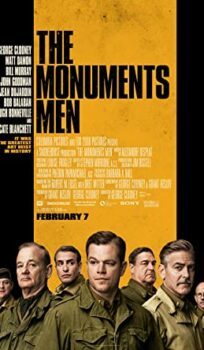The Monuments Men(2014)
Submitted by Steve
POOPER:
All of the Monuments Men survive the war, except for Jeffries (who died trying to protect the Bruges Madonna statue) and Jean-Claude (who was caught in a crossfire). Through their efforts, the Monuments Men are able to recover and return tens of thousands of pieces of art, including the Altar of Ghent and the Bruges Madonna.
LONG VERSION
In 1943, during World War II, the Allies are in the process of conquering Italy, but the battles are destroying many irreplaceable pieces of art. Lieutenant Frank Stokes (George Clooney) meets with President Roosevelt and is tasked with assembling a team of art curators, historians, and museum directors to recover and return as many pieces of art as possible. During the war, the Nazis have been raiding museums and private art collections (mostly from Jewish collectors) and are either sending the pieces to Germany to be placed in a proposed “Fuhrer Museum” or are given to high ranking officers.
Stokes quickly assembles his team, which consist of: James Granger (Matt Damon), Richard Campbell (Bill Murray), Walter Garfield (John Goodman), Jean-Claude Clermont (Jean Dujardin), Preston Savitz (Bob Balaban), and Donald Jeffries (Hugh Bonneville). After completing basic training, they arrive in France following D-Day. The self-dubbed Monuments Men, along with their driver/translator Sam Epstein (Dimitri Leonidas), are not having much luck at first, as Allied officers refuse to risk the lives of their soldiers just to save some art. With the war quickly turning in the Allies favor, Stokes realizes that they might not have much time to find the art, so they split up and travel to various parts of France and Belgium, hoping to find the artwork itself or clues to where the Nazis took it.
Granger travels to Paris, where he meets up with the Resistance. After telling them his mission, they put him in contact with Claire Simone (Cate Blanchett), the sister of a fallen comrade. Claire works in an art gallery that has been taken over by the Nazis, and the new German curator, Victor Stein, has been taking the artwork for himself or is giving them to other officers. With Paris about to be liberated, Stein orders all of the artwork loaded onto a train and takes it somewhere in Germany. When Granger goes to Claire and tells him what he plans to do, she refuses to help him. She knows that the Soviet army is also recovering artwork, but they are keeping it for themselves as war reparations, and she thinks the Allies will do the same. Later, Granger shows Simone the Nero Decree, which orders the Nazis to destroy all artwork if Hitler is ever killed or Germany falls. This, combined with seeing Granger return a portrait to a looted Jewish home, causes her to change her mind and she gives him a ledger that she kept, showing each piece that Stein took and who their rightful owners are.
Jeffries travels to Bruges, Belgium, which is still under Nazi control. He sneaks into a church, which is the home of a statue made by Michelangelo of the Madonna and Child, known as the Bruges Madonna, that he once saw as a child. That night, the Nazis come to the church to take the Bruges Madonna. Jeffries tries to stop them, but he is killed and the statue is taken away. Garfield and Clermont learn of a cache of artwork in a nearby French village. They get lost along the way, and get caught in an ambush. Clermont is mortally wounded in the crossfire, and dies after Garfield is unable to find medical help in time. Campbell and Savitz learn of a large series of panels of artwork depicting the life of Christ, known as the Altar of Ghent, that was taken by the Nazis after some priests attempted to smuggle it out of Belgium. With the Allied army now in Germany, Campbell and Savitz follow them and stumble onto a farm that contains several pieces of art. The farmer, who turns out to be Victor Stein from Paris, is busted when Savitz sees that all of the paintings came from the looted Rothchild Collection.
Stokes and Sam Epstein travel to the town that Garfield and Clermont were looking for, only to see it destroyed. Later, Sam is able to determine that the map they captured showing the locations of the artwork are actually of the mines near those towns. They travel to the nearby salt mine, and they discover nearly 16,000 pieces of art, as well as the hidden gold reserves of the German National Treasury. Stokes recalls all of the remaining members of the team and they begin checking out all the mines on the map. But while the Monuments Men are searching the mines, the Nazis have begun to enact the Nero Decree, and they begin to destroy the artwork hidden in other mines. Days later, the war is over, but the search for the artwork continues. The Monuments Men are at a mine in Austria, which they learn contains the Altar of Ghent, when they learn that the mine is in the part of the country that is going to be in the Soviet Zone of Occupation, and their army is heading their way. With little time, the team gathers as much artwork as they can carry, including the pieces of the altar. Stokes goes to empty a nearby mine cart to load artwork when he sees it contains the Bruges Madonna, the piece that Jeffries died trying to protect. The entire team pushes the cart out of the mine, gets everything loaded onto their trucks, and flees the area just as the Soviets arrive.
Some time later, Stokes is meeting with President Truman for a mission debriefing. Stokes is listing many of the pieces they recovered, as well as other valuable items, and says the long process of tracking down the owners is still ongoing. Stokes is asking for permission to keep looking for stolen artwork when Truman asks him if losing two members of his team was worth it, and would anyone remember what they did 30 years from now. The movie ends 30 years later when an elderly Stokes (Nick Clooney, George’s father), with his grandson in tow, visits the Bruges Madonna and says, “yes”.

